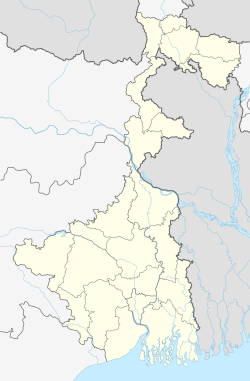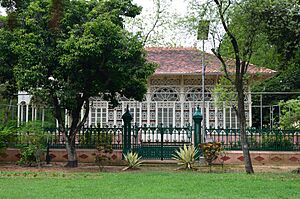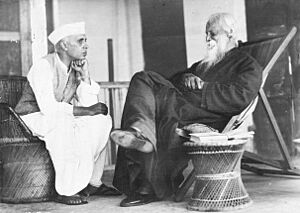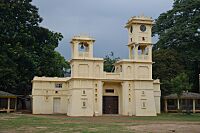Shantiniketan facts for kids
Quick facts for kids
Shantiniketan
Bolpur
|
|||||||||||||
|---|---|---|---|---|---|---|---|---|---|---|---|---|---|
|
Neighbourhood
|
|||||||||||||
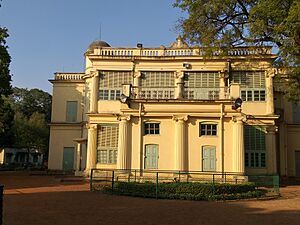
Shantiniketan Griha
|
|||||||||||||
| Country | India | ||||||||||||
| State | West Bengal | ||||||||||||
| District | Birbhum | ||||||||||||
| Elevation | 30 m (100 ft) | ||||||||||||
| Languages | |||||||||||||
| • Official | Bengali, English | ||||||||||||
| Time zone | UTC+5:30 (IST) | ||||||||||||
| PIN |
731204 (Bolpur)
731235 (Santiniketan) 731236 (Sriniketan) |
||||||||||||
| Telephone/STD code | +91 03463 | ||||||||||||
| Lok Sabha constituency | Bolpur | ||||||||||||
| Vidhan Sabha constituency | Bolpur | ||||||||||||
|
|||||||||||||
Shantiniketan (which means "Abode of Peace") is a special neighborhood in the town of Bolpur, located in West Bengal, India. It's about 152 kilometers (94 miles) north of Kolkata. This peaceful place was first started by Maharshi Devendranath Tagore. Later, his son, the famous poet Rabindranath Tagore, made it into a unique university town called Visva-Bharati.
In 2023, Shantiniketan was recognized as a UNESCO World Heritage Site. This means it's a place of great importance to the world's history and culture.
Contents
- History of Shantiniketan
- Exploring Shantiniketan's Landscape
- The Tagore Family and Shantiniketan
- Weather in Shantiniketan
- Getting to Shantiniketan
- Learning at Visva Bharati University
- Culture and Festivals
- Sinha Sadan: A Historic Building
- Ballabhpur Wildlife Sanctuary: Deer Park
- Amar Kutir: Crafts and History
- Sonajhuri Haat: Village Market
- Images for kids
- See also
History of Shantiniketan
How Shantiniketan Began
In 1863, Debendranath Tagore, Rabindranath's father, rented a piece of land about 20 acres (81,000 square meters) big. This land had two special chhatim trees. He built a guest house there and named it Shantiniketan, meaning "the abode of peace." Over time, the entire area became known by this peaceful name.
The nearby town of Bolpur was quite small in the mid-1800s. It grew as Shantiniketan became more important. Debendranath built a special prayer hall for the Brahmo Samaj faith. This hall was inspired by the famous Crystal Palace in London. It had a tiled roof and a white marble floor, but most of it was made of glass. This unique building quickly became a popular attraction.
Rabindranath Tagore's Vision
Rabindranath Tagore first visited Shantiniketan when he was 17 years old in 1878. In 1888, his father, Debendranath, set aside the entire property to create a school. In 1901, Rabindranath started a school called Brahmacharyaashrama, which later became known as Patha Bhavana.
In 1913, Rabindranath Tagore won the Nobel Prize in Literature. This was a huge honor for him and his family, who were already very important in Bengal's culture. The Tagore family home in Kolkata, Jorasanko Thakur Bari, was always full of literature, music, art, and theater.
Rabindranath Tagore founded Visva Bharati in 1921. His goal was to create a place where people from all over the world could learn and share ideas. In 1951, Visva Bharati became a central university and an important national institution in India.
Exploring Shantiniketan's Landscape
Location and Natural Beauty
Shantiniketan is located at 23°41′N 87°41′E / 23.68°N 87.68°E, about 56 meters (187 feet) above sea level. The area is surrounded by two rivers, the Ajay and the Kopai.
Long ago, Shantiniketan had many forests. But soil erosion caused some areas to become barren, creating a unique landscape called khoai. However, thanks to the hard work of botanists, many different plants and trees from all over India now grow here. Even though the surrounding areas have changed, the heart of Shantiniketan still feels very close to nature.
Popular Places to Visit
Shantiniketan is a popular tourist spot, attracting over a million visitors each year. Here are some notable places:
Rabindra Bhavana: A Poet's Legacy
Rabindra Bhavana was founded in 1942, shortly after Rabindranath Tagore passed away. It's the main center for learning about the poet at Visva Bharati. It has a museum, archives, and a library. You can find many of Rabindranath's original writings, letters, paintings, and sketches here. It also holds 40,000 books and many journals, photos, and items from his life. It's often the first place visitors want to see. Rabindranath's son, Rathindranath Tagore, created it as a museum and research center.
The Uttarayan Complex: Tagore's Homes
The Uttarayan Complex is in the northern part of Shantiniketan, next to Rabindra Bhavana. It has five houses built by Rabindranath Tagore himself: Udayan, Shyamali, Konark, Udichi, and Punascha. His son, Rathindranath, designed the beautiful gardens around these homes.
Shyamali and Konark are unique mud houses. Shyamali was an experiment, with its design inspired by the Borobudur temple. Its outer walls are decorated with amazing relief work created by students from Kala Bhavana under the guidance of Nandalal Bose. The figures of Santals near the main door were made by Ramkinkar Baij. Even Mahatma Gandhi and Kasturba Gandhi stayed in Shyamali as guests!
Udayan is the grandest house in the complex, used for important guests. Each part of Udayan is on a different level, making it very special. In 2013, Visva Bharati opened a museum called Guha Ghar in this complex, honoring Rathindranath Tagore.
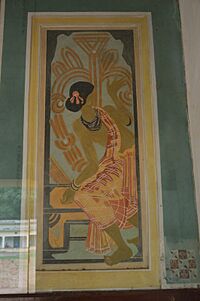
The Ashram Complex: The Oldest Part
The Ashram Complex is the oldest part of Shantiniketan. Here, Debendranath Tagore built the Santiniketan Griha and the stunning stained-glass prayer hall. Patha Bhavana school was built after Rabindranath started living here. It features beautiful paintings by Nandalal Bose.
Natun Bari (New House) was built in 1902 for living. Kalo Bari (Black House) is a very special building made of mud and coal tar, with lots of decorations. There are many other historic houses like Dehali, Santoshalaya, Singha Sadan, and more, each with its own interesting story.
Visva Bharati Institutes: Learning and Art
Visva Bharati was created to be a center for culture, where people could explore arts, languages, music, and humanities. Many specialized institutes were built for different subjects:
- Cheena Bhavana: For Chinese studies.
- Hindi Bhavana: For Hindi studies.
- Kala Bhavana: For fine arts, including painting, sculpture, and graphic art.
- Sangit Bhavana: For music and dance, offering courses in Rabindra Sangit, classical music, and various dance forms.
- Bhasa Bhavana: For language studies, including Bengali, Japanese, and many others.
- Nippon Bhavana: For Japanese studies.
- Bangladesh Bhavana: For studies related to Bangladesh.
Many of these buildings are decorated with amazing artworks by famous artists.
Outdoor Art by Ramkinkar Baij
Shantiniketan's landscape is filled with large sculptures by Ramkinkar Baij (1906–1980). These sculptures often show everyday life, like a Santal family with their dog, or workers running. They are placed outdoors, blending into the natural surroundings. For example, his tall sculpture of Sujata, a disciple of Buddha, is placed among tall eucalyptus trees, creating a perfect scene. Nandalal Bose helped create an environment where art was a natural part of life in Shantiniketan.
The Tagore Family and Shantiniketan
She is our own, the darling of our hearts,
Santiniketan.
hearts.
In the shadows of her trees we meet
in the freedom of her open sky.
Our dreams are rocked in her arms.
Her face is a fresh wonder of love every
time we see her,
for she is our own, the darling of our
—Rabindranath Tagore
Shantiniketan was truly a family project, started and grown by members of the Tagore family.
- Debendranath Tagore founded it.
- Rabindranath Tagore wrote many of his famous works here.
- His son, Rathindranath Tagore, was one of the first students at the school. After his father's death in 1941, Rathindranath took on all the responsibilities. When Visva Bharati became a central university in 1951, he was its first vice-chancellor.
- Pratima Devi, Rathindranath's wife, was also very involved with Visva Bharati from a young age.
- Mira Devi, Rabindranath's youngest daughter, lived in Malancha in the Ashram complex.
- Dwijendranath Tagore, Rabindranath's eldest brother, spent his last twenty years in Shantiniketan.
- Dinendranath Tagore, Dwijendranath's grandson, was the first principal of Sangit Bhavana (the music institute).
- Indira Devi Chaudhurani, Rabindranath's niece, took charge of Sangit Bhavana and even served as acting vice-chancellor for a short time.
- Supriyo Tagore, a great-grandson of Satyendranath Tagore, was a student and later the longest-serving principal of Patha Bhavana. He now runs a home for orphans. His son, Sudripta, is also working to set up a school based on Rabindranath's ideas.
Weather in Shantiniketan
Shantiniketan has a moderately warm climate.
- Summer: From March to May, temperatures can reach around 35-42°C (95-108°F).
- Winter: From December to February, temperatures are cooler, around 10-15°C (50-59°F).
- Monsoon: June to September brings heavy rainfall.
The highest temperature ever recorded was 47.0°C (116.6°F) on June 10, 1966. The lowest was 4.9°C (40.8°F) on January 9, 2013. The area gets about 1480mm (58 inches) of rain each year.
| Month | Jan | Feb | Mar | Apr | May | Jun | Jul | Aug | Sep | Oct | Nov | Dec | Year |
|---|---|---|---|---|---|---|---|---|---|---|---|---|---|
| Record high °C (°F) | 33.0 (91.4) |
37.0 (98.6) |
42.0 (107.6) |
45.9 (114.6) |
46.6 (115.9) |
47.0 (116.6) |
41.6 (106.9) |
36.8 (98.2) |
39.1 (102.4) |
37.1 (98.8) |
34.2 (93.6) |
30.7 (87.3) |
47.0 (116.6) |
| Mean maximum °C (°F) | 28.7 (83.7) |
32.8 (91.0) |
38.2 (100.8) |
41.3 (106.3) |
41.7 (107.1) |
40.2 (104.4) |
36.2 (97.2) |
34.9 (94.8) |
35.1 (95.2) |
34.3 (93.7) |
32.1 (89.8) |
29.1 (84.4) |
42.3 (108.1) |
| Mean daily maximum °C (°F) | 24.7 (76.5) |
28.2 (82.8) |
33.4 (92.1) |
36.6 (97.9) |
36.7 (98.1) |
34.9 (94.8) |
32.9 (91.2) |
32.5 (90.5) |
32.4 (90.3) |
31.6 (88.9) |
29.5 (85.1) |
26.1 (79.0) |
31.6 (88.9) |
| Mean daily minimum °C (°F) | 11.6 (52.9) |
14.7 (58.5) |
19.3 (66.7) |
23.3 (73.9) |
25.0 (77.0) |
26.0 (78.8) |
26.0 (78.8) |
26.0 (78.8) |
25.3 (77.5) |
22.5 (72.5) |
17.3 (63.1) |
13.0 (55.4) |
20.8 (69.4) |
| Mean minimum °C (°F) | 7.8 (46.0) |
10.5 (50.9) |
14.6 (58.3) |
19.0 (66.2) |
20.8 (69.4) |
22.7 (72.9) |
23.9 (75.0) |
23.8 (74.8) |
23.1 (73.6) |
18.5 (65.3) |
13.0 (55.4) |
9.4 (48.9) |
7.7 (45.9) |
| Record low °C (°F) | 5.0 (41.0) |
6.0 (42.8) |
11.2 (52.2) |
14.6 (58.3) |
18.1 (64.6) |
18.7 (65.7) |
20.0 (68.0) |
22.4 (72.3) |
17.7 (63.9) |
15.6 (60.1) |
9.7 (49.5) |
6.1 (43.0) |
5.0 (41.0) |
| Average rainfall mm (inches) | 11.6 (0.46) |
25.1 (0.99) |
33.2 (1.31) |
52.0 (2.05) |
113.8 (4.48) |
229.7 (9.04) |
343.2 (13.51) |
296.7 (11.68) |
267.5 (10.53) |
87.7 (3.45) |
10.5 (0.41) |
9.0 (0.35) |
1,479.9 (58.26) |
| Average rainy days | 1.2 | 1.9 | 2.4 | 3.5 | 6.3 | 11.6 | 15.7 | 15.1 | 11.9 | 4.7 | 0.9 | 0.5 | 75.6 |
| Average relative humidity (%) (at 08:30 IST) | 76 | 68 | 61 | 66 | 73 | 80 | 85 | 86 | 86 | 81 | 75 | 75 | 76 |
| Source: India Meteorological Department | |||||||||||||
Getting to Shantiniketan
Travel by Train
Bolpur Shantiniketan railway station is well connected to major cities like Kolkata (Sealdah, Howrah, Kolkata stations), Malda Town, and New Jalpaiguri in West Bengal. You can also find trains to Guwahati Railway Station in Assam.
Travel by Bus and Car
There is a direct AC Volvo bus service from Kolkata to Bolpur Shantiniketan. You can also find buses and private cars from places like Durgapur City Centre, Katwa, and Berhampore. Soon, there will be services from Santragachi Railway Station in Howrah.
Learning at Visva Bharati University
Shantiniketan is a university town with many educational opportunities.
- Schools: Patha Bhavana and Siksha Satra are schools for younger students.
- University Courses: Visva-Bharati offers many courses in humanities, science, and education. It also has a strong focus on music, dance, art, and languages.
- Music and Dance: Sangit Bhavana teaches Rabindra Sangit, Hindustani classical vocal, and various instruments like sitar and tabla. It also offers Kathakali and Manipuri dance.
- Fine Arts: Kala Bhavana has courses in painting, mural art, sculpture, graphic art, and design.
- Languages: Bhasa Bhavana offers undergraduate and postgraduate courses in many languages, including Arabic, Bengali, Chinese, Japanese, and Sanskrit. Vidya Bhavana offers shorter courses in even more languages.
- Crafts: You can take certificate courses in leather craft, book binding, batik work, and handmade paper making.
- Agriculture and Rural Development: Shantiniketan also has courses in these important fields.
This is just a small look at the wide range of subjects you can study here!
Culture and Festivals
Shantiniketan is famous for its rich literary and artistic culture. Key figures like Rabindranath Tagore and Nandalal Bose have shaped its artistic heritage. Visva Bharati acts as the main cultural hub.
Poush Mela: A Lively Fair
In the Birbhum district, fairs (called mela) are very important. They are not just for trade but also for people to meet and share culture. The biggest and most famous fair is the Poush Mela, held in Shantiniketan for three days starting on the 7th day of the Bengali month of Poush. This festival celebrates the day Debendranath Tagore and his followers officially joined the Brahmo faith in 1843.
Seasonal Celebrations
Shantiniketan celebrates the changing seasons with many colorful festivals. These festivals often focus on traditional Indian customs and rituals.
- Basanta Utsav: This is how Shantiniketan celebrates Holi, the festival of colors, welcoming spring. Students sing and dance to Tagore's songs, and then everyone spreads colored powders (abir).
- Barsha Mangal: Celebrated in July-August, this festival welcomes the rainy season with cultural programs.
- Ananda Bazar: A fair where students sell their handicrafts, held on Mahalaya day.
- Sharad Utsav: Students celebrate this before leaving for their puja vacations.
- Nandan Mela: Held on December 1-2, this fair celebrates Nandalal Bose's birthday and is popular with art lovers.
- Briksharopan and Halkarshan: These festivals in August highlight the connection between humans and nature.
- Maghotsab: Celebrated in late January, this marks the founding of the Brahmo Samaj.
- Rabindra Jayanti: Rabindranath Tagore's birthday is celebrated in mid-April, along with the Bengali New Year.
Many other anniversaries and cultural events happen throughout the year.
Sinha Sadan: A Historic Building
Shantiniketan was originally part of the land owned by the Sinha family of Raipur. Satyendra Prasanna Sinha, 1st Baron Sinha donated money to build Sinha Sadan, which has a clock tower and a bell. This building is famous because it's where Oxford University gave an honorary doctorate degree to Rabindranath Tagore.
Ballabhpur Wildlife Sanctuary: Deer Park
Ballabhpur Wildlife Sanctuary, also known as Deer Park, is located just 3 kilometers (1.8 miles) from Shantiniketan. It was started in 1977 in an area that used to suffer from soil erosion (khoai). Now, it's a large wooded area with herds of deer and is a natural home for many birds.
Amar Kutir: Crafts and History
Amar Kutir means "my cottage." It was once a safe place for people involved in the Indian independence movement. Today, it's a cooperative society that promotes local arts and crafts. It's located on the banks of the Kopai River, about 15 kilometers (9 miles) from central Shantiniketan.
Sonajhuri Haat: Village Market
Every Saturday and Sunday, you can visit the haat (a local market) at Sonajhuri, near Shantiniketan. This village market is a great place to buy local handicrafts and listen to folk music performed by tribal groups. You can find wooden crafts, terracotta items, metal ornaments, dhokra art, and locally made clothes. It's a wonderful way to experience the local culture of Shantiniketan.
Images for kids
See also
 In Spanish: Santiniketan para niños
In Spanish: Santiniketan para niños


